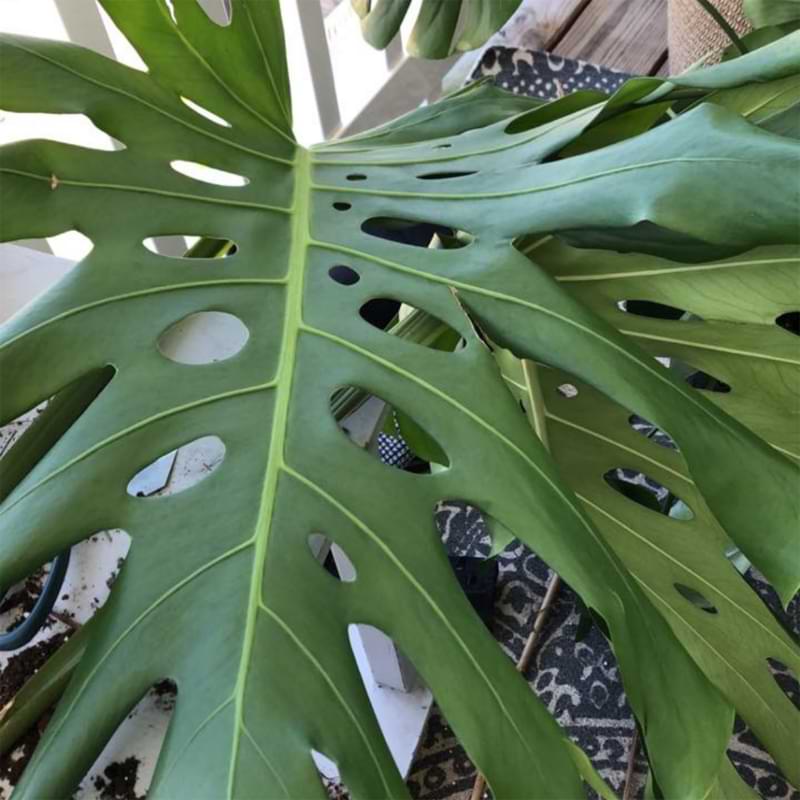One of the most important parts of monstera care is learning to recognize signs that your monstera is unhappy. The first place you’ll notice most of these signs is in the leaves. So what should you do if you notice your monstera leaves curling?
The most likely culprit is thirst or dryness. If your monstera’s leaves are curling and even a little crunchy, that’s a sure sign that it might not be getting enough water or that the environment is too dry.
However, dumping a bunch of extra water on your plant might not solve the problem! It’s important to determine the reason why your monstera is drying out so you can fix the underlying problem, not just slap on a Band-Aid solution that will only help temporarily—or worse, exacerbate the problem!
Here are three reasons why your monstera may be too dry and what to do if you notice your monstera leaves curling and drying out.
Monstera Leaves Curling: Why Your Monstera May Be Drying Out

1. Underwatering
The first and most obvious reason may be that you simply aren’t giving your monstera enough water.
This is common when plant parents are trying to avoid overwatering, which is equally problematic. A lot of plant owners will swing too far to the other side of the spectrum and dry their plants out!
I highly suggest using a moisture meter to monitor your monstera’s soil so you know when it’s ready for a drink. When your meter reads a 3 or 4 at the center of the root ball, you know your monstera is ready for water.
You can also stick your finger into the soil to see if it’s dry 2-3 inches down. This doesn’t give you an indication of what’s going on inside the root ball, but if your soil is decently well aerated, this is usually a good sign that it’s time to water.
Learn more about watering your monstera properly:
How to Water a Monstera: The Ultimate Guide
Should You Bottom Water a Monstera Plant?
The Best Monstera Moisture Meter for your Monstera Plant
2. Low Humidity
Another reason why your monstera leaves may curl is low humidity.
Even if you live in a fairly humid area, you may still run into this problem if you use indoor climate control. Heating and air conditioning tend to make the air very dry, so it might be helpful to put your plant on a humidity tray or set up a humidifier nearby to keep the leaves soft and supple. And never place your plant near a heating or AC vent, fireplace, or space heater. (Those are all a one-way ticket to curly, crispy leaves!)
If you suspect the humidity in your home may be too low for your monstera, try this handy humidity meter to find out for sure so you can make adjustments.
3. Compacted Soil or Wrapped Roots
If your monstera’s roots are tightly wrapped or if the soil is hard and compacted in the pot, your monstera may experience symptoms of dryness, like crispy brown spots and curling leaves, as well as overwatering, like dark-brown spots and mushy stems.
This is because when soil is compacted, it doesn’t readily absorb water (this leads to underwatering) or drain well once it does absorb water (which leads to overwatering and even root rot). Additionally, if the roots are wrapped, they may struggle to absorb water and nutrients from the soil.
The solution here is to repot your monstera into fresh, well-aerated soil and a clean pot with drainage that’s 2-3 inches larger than the root ball.
Not sure what kind of soil to use for your monstera? Here are our top picks for DIY and pre-mixed monstera soils.
Level Up Your Monstera Care
Watering your monstera properly is key for keeping it healthy and growing more of those big, beautiful leaves! Become a monstera care expert with our resources and guides:
How to Care For A Monstera Indoor Plant
The Ultimate Guide to Monstera Varieties





